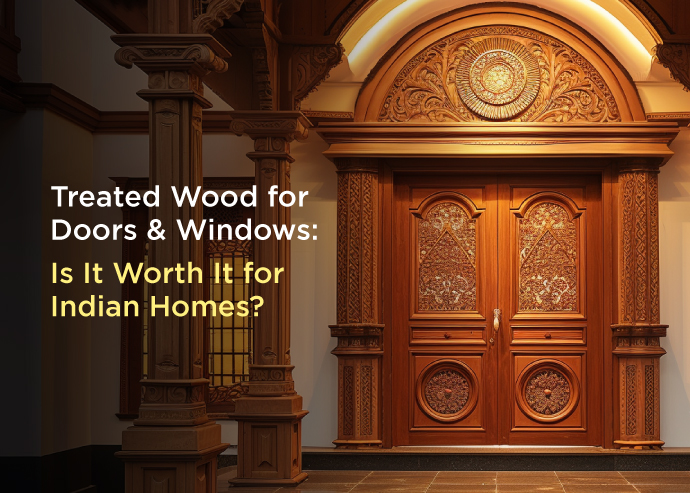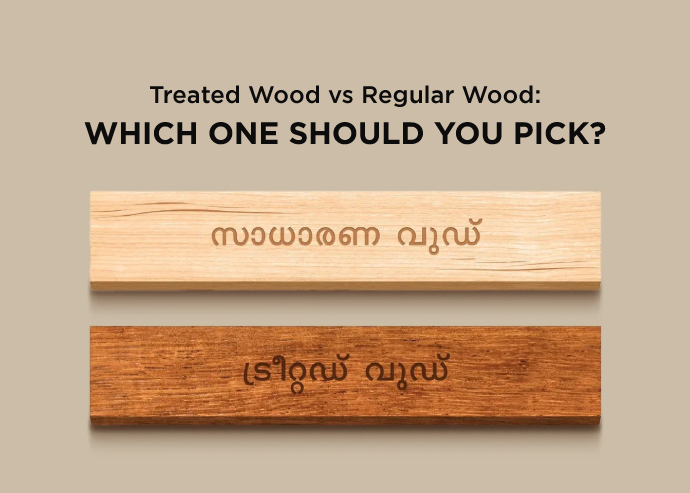Blog Details

Treated Wood Offers Long-Lasting Durability and Indoor Safety
Why Treated Wood Is Durable and Safe for Indoor Use
Walk into any beautifully built home in Kerala and you’ll notice one thing right away — wood. From doors and windows to furniture and ceilings, it adds warmth, character, and timeless appeal. But here’s the catch: the same humid weather that keeps Kerala green and lush also puts wood through a real test. Termites, moisture, and decay can quietly eat away at the beauty and strength of wooden structures. That’s where treated wood steps in.
This article unpacks what treated wood really is, how it’s made more durable, and – a question many homeowners have – whether it’s safe for indoor use. We’ll also look at where treated wood makes sense, how to choose the right type, and what to keep in mind if you’re planning to use it for interiors.
What Is Treated Wood?
In simple terms, treated wood is natural timber that has been enhanced to resist damage from moisture, fungi, and insects. The process involves forcing protective preservatives deep into the wood fibers under controlled pressure. This doesn’t change the look of the wood much, but it dramatically improves its lifespan and strength.
The most common types of treatment include:
- Pressure treatment – where chemicals are infused into the wood using high pressure.
- Thermal treatment – where heat is used to change the wood’s structure and make it less absorbent.
- Natural oil treatment – using oils like linseed or neem for mild protection, often preferred for lighter indoor use.
In India, pressure-treated wood is the most common, as it’s effective against the two biggest threats — termites and moisture.
Why Durability Matters
Untreated wood can look perfect when new, but over time, exposure to humidity, leaks, or even coastal air can cause it to swell, rot, or get eaten from the inside. Repairing or replacing wood elements can be expensive and inconvenient.
Treated wood, on the other hand, is built to last. Here’s what makes it a smart investment:
- Resistance to decay: The preservatives prevent fungal growth and rot even in damp areas.
- Termite protection: In a tropical climate like Kerala’s, this alone makes a big difference.
- Longer life span: Treated wood can last several years longer than untreated wood, especially in exposed or semi-exposed areas.
- Structural stability: It’s less likely to warp or crack due to moisture changes.
In practical terms, this means your furniture, decking, or wood frames remain strong and attractive for much longer.
But Is Treated Wood Safe for Indoor Use?
This is where most people pause – and rightly so. Since chemical preservatives are used in treatment, it’s important to know which types are safe to bring indoors.
Modern treated wood is much safer than what was used decades ago. Reputable manufacturers today use low-toxicity preservatives that don’t release harmful fumes or residues once the wood has been properly cured. The key lies in understanding the treatment type and the intended use.
Here’s how to think about it:
- For structural indoor use (like roof trusses, frames, subfloors): pressure-treated wood is safe as long as it’s completely sealed or covered with paint, polish, or laminate.
- For visible indoor surfaces (like furniture, wall panels, or ceilings): choose wood treated with non-arsenic and low-VOC preservatives. These are certified for interior use and safe once dry.
- For kitchens or children’s rooms: opt for naturally treated or heat-treated wood instead of chemically treated varieties.
Good ventilation, sealing, and finishing also ensure that any residual chemicals stay locked in the wood.
Where Treated Wood Makes the Most Sense Indoors
You don’t need treated wood everywhere — but in some indoor areas, it’s a game-changer.
1. Roof structures and ceilings
In Kerala, traditional sloped roofs and open ceilings face constant exposure to humidity and occasional leaks. Treated wood helps prevent decay and termite damage in these hidden structural elements.
2. Door and window frames
Frames often come in contact with outdoor air and rain. Treated wood resists moisture, keeping doors and windows sturdy for years.
3. Bathrooms and utility areas
Wooden cabinets or paneling in semi-wet spaces benefit from mild treatment, reducing swelling and mold formation.
4. Furniture in coastal regions
In coastal towns like Kochi, Alappuzha, or Kozhikode, the salty air can cause faster wood deterioration. Treated wood offers better protection against such environmental stress.
Safety Tips When Using Treated Wood Indoors
If you’re planning to use treated wood inside your home, a few practical steps can go a long way in ensuring safety and longevity:
- Buy from certified suppliers. Make sure the wood has been treated as per Bureau of Indian Standards (BIS) or equivalent certifications.
- Ask about the preservative. Choose products labeled safe for residential or interior use. Avoid older formulations containing arsenic or heavy metals.
- Let it cure fully. Newly treated wood should be allowed to air out before installation.
- Seal or finish the surface. Paint, varnish, or laminate locks in preservatives and prevents exposure.
- Avoid cutting or sanding indoors. Dust from treated wood should not be inhaled. Always cut or drill in open areas.
- Dispose responsibly. Never burn treated wood scraps; dispose of them as per local waste rules.
These steps keep your indoor environment healthy while you enjoy the benefits of durable, natural wood.
The Balance Between Nature and Protection
Kerala’s love for wood runs deep — it’s part of the architecture, the furniture, and even the emotional feel of a home. But balancing beauty with practicality matters. Treated wood bridges that gap. It allows us to enjoy the charm of natural timber without constantly worrying about decay, termites, or maintenance.
When sourced responsibly and used correctly, treated wood is not only durable but also safe for homes. The key is awareness — knowing what type of treatment your wood has gone through, and where it’s best used.
Final Thoughts
Wood brings warmth that no other material can. And with the right treatment, it can also bring peace of mind. Whether you’re building a new home, renovating an old one, or choosing furniture that lasts, treated wood offers a simple promise — strength that stands up to time and weather, without losing the beauty of nature.
In a place where the rains are generous and the climate tests every building material, that promise is worth holding on to.




